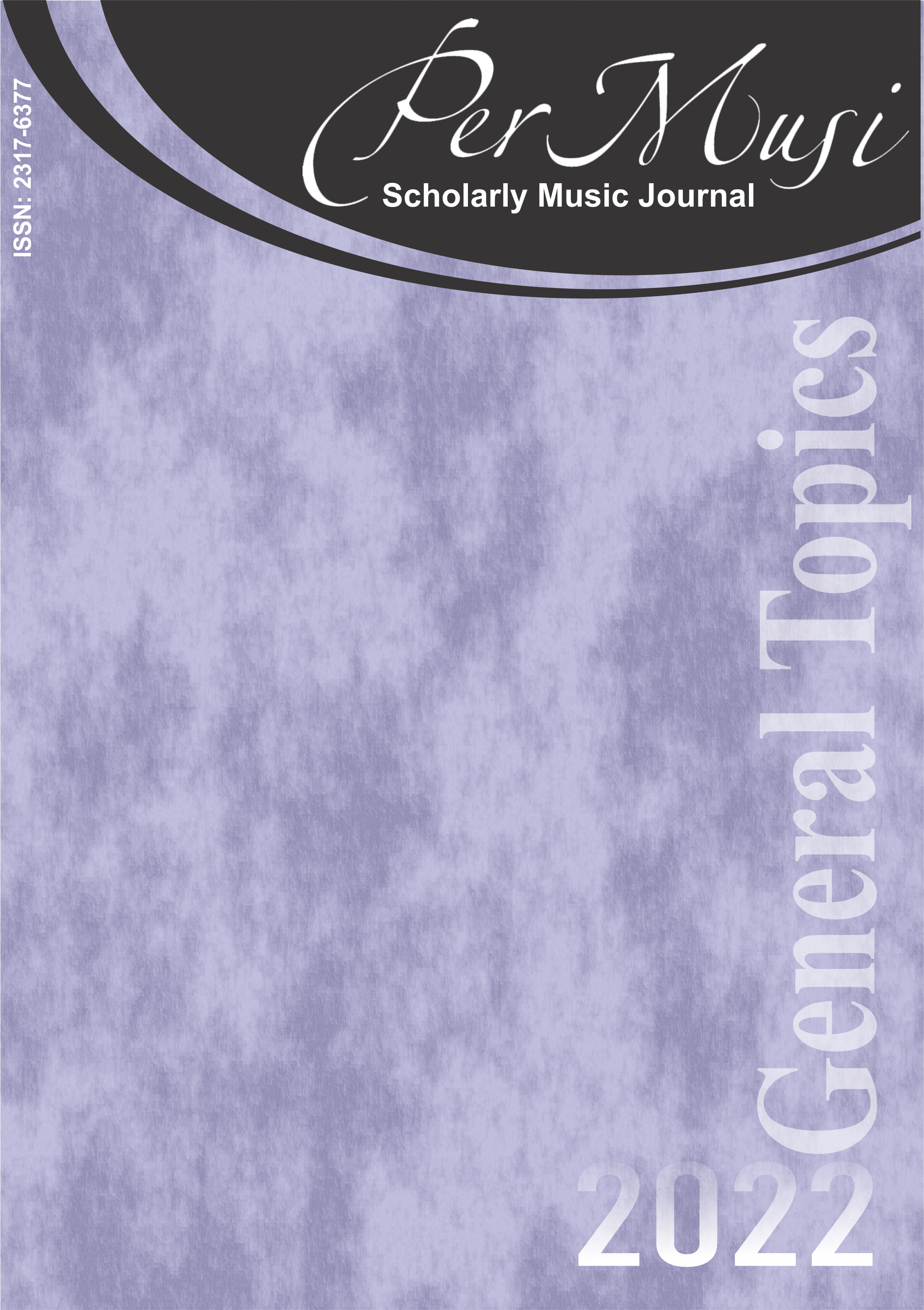Gradações harmônicas no terceiro movimento do Quarteto de cordas n. 2 de György Ligeti
o conceito reavaliado de micropolifonia
DOI:
https://doi.org/10.35699/2317-6377.2022.37400Palavras-chave:
György Ligeti, Quarteto de cordas, Gradação, MicropolifoniaResumo
A partir da Lacrimosa, do Requiem, Ligeti modifica sua linguagem ao sair gradualmente da harmonia do cluster. Ele passa a inserir "buracos" na textura e a utilizar um número mais reduzido de instrumentos. Isto implica numa reavaliação da técnica da micropolifonia (utilizada em obras anteriores para grande massa sonora) e numa adaptação desta textura ao novo contexto. As consequências destas mudanças, para a percepção, são evidentes; isto torna possível a audição de muitos detalhes da trama sonora que ficavam submersos nos tecidos sonoros de obras como Apparitions, Atmosphères e o Requiem. Na nossa análise, mostramos como acontece esse processo no terceiro movimento do seu Quarteto de cordas no 2. Baseamos nosso estudo na ideia de que o conceito de gradação serve como elemento central na construção da música.
Referências
Bernard, Jonathan W. 1987. “Inaudible structures, audible music: Ligeti’s problem, and his solution.” Music Analysis (Chichester) 6 (3): 207–236.
_________________. 1994. “Voice leading as a spatial function in the music of Ligeti.” Musical Analysis (Chichester) 13 (2-3): 227–253.
Caznok, Yara Borges. 2003. Música: entre o audível e o visível. São Paulo, SP: Editora UNESP.
Clendinning, Jane Piper. 1993. “The pattern-meccanico compositions of György Ligeti.” Perspectives of New Music (Seattle) 31: 192–234.
Delaplace, Joseph. 2007. György Ligeti: un essai d’analyse et d'esthétique musicales. Rennes: Presses Universitaires de Rennes.
Dubois, Jean. 2011. Dicionário de Linguística. São Paulo: Cultrix.
Escot, Pozzi. 1988. “‘Charm’d magic casements’, mathematical models in Ligeti.” Sonus 9 (1): 17–37.
Ferraz, Silvio. 1990. “Análise e percepção textural.” Cadernos de estudo: análise musical, São Paulo 3: 68–79.
Fessel, Pablo. 2001. “Forma y concreción textural en ‘Apparitions’” (1958-59) de György Ligeti. Revista del Instituto Superior de Música, Santa Fé 11: 53–87.
Fontanier, Pierre. 1977. Les figures du discours. Paris: Flammarion.
Hicks, Michael. 1993. “Interval and form in Ligeti’s ‘Continuum’ and ‘Coulée.’” Perspectives of new music 31 (1): 172–190.
Iverson, Jennifer Joy. 2009. “Historical memory and György Ligeti’s sound-mass music 1958-1968.” Tese de Doutorado, The University of Texas at Austin.
Ligeti, György. 2001. Neuf essais sur la musique. Genève: Contrechamps.
___________. 2013. L'atelier du compositeur. Genève: Contrechamps Éditions.
Manzolli, Jônatas e Luvizotto, André Luiz. 2015. “Análise de ‘Ramifications’ de Ligeti utilizando Transformada Wavelet.” Nics Reports 10.
Michel, Pierre. 1995. György Ligeti. Paris: Minerve.
Moisés, Massaud. 2004. Dicionário de termos literários. São Paulo: Cultrix.
Molinié, Georges. 1992. Dictionnaire de rhétorique. Paris: Librairie Générale Française.
Morrison, Charles Douglas. 1985. “Stepwise continuity as a structural determinant in György Ligeti’s ‘Ten Pieces for wind quintet.’” Perspectives of new music 24 (1): 158–182.
Poirier, Alain. 1996. “György Ligeti: l'enjeu thématique dans le ‘Deuxième quatuor à cordes.’” Musurgia 3 (4): 45–54.
Power, Richard. 1995. "An analysis of transformation procedures in György Ligeti’s ‘String Quartet no 2.’” Tese de Doutorado, Urbana-Champaign, Illinois: University of Illinois at Urbana-Champaign.
Prost, Christine. 1991. “György Ligeti: ‘Lux Aeterna’, pour chœur mixte a cappella.” Analyse musicale 25: 37–51.
Reiprich, Bruce. 1978. “Transformation of coloration and density in György Ligeti’s ‘Lontano.’” Perspectives of New Music 16 (2): 167–180.
Roig-Francolí, Miguel A. 1995. “Harmonic and formal processes in Ligeti’s net-structure compositions.” Music theory spectrum 17 (2): 242–267.
Sabbe, Herman. 1980-81. “Techniques médiévales en musique contemporaine: histoire de la musique et sens culturel.” Revue belge de Musicologie 34: 220–233.
Sapir, Edward. 1949. “Grading: a study in semantics.” In Selected writings of Edward Sapir in language, culture and personality, editado por David G. Mandelbaum, 122-149. Berkeley: University of California Press
Schaeffer, Pierre. 1966. Traité des objets musicaux. Paris: Seuil.
Straus, Joseph Nathan. 2005. Introduction to post-tonal theory. Upper Saddle River, New Jersey: Pearson/ Prentice Hall.
Souza, Allan Christian Domingues. 2019. “A tríplice confluência histórico-técnica no conceito de micropolifonia de György Ligeti (1957-1967): a concepção de um estilema tecnomórfico híbrido.” Tese de Doutorado, São Paulo, SP: Universidade Estadual Paulista “Julio de Mesquita Filho”, Instituto de Artes.
Toop, Richard. 1990. “L’illusion de la surface.” Contrechamps 12–13: 61–97.
Vitale, Claudio H. 2008. “‘Dez peças para quinteto de sopros’ de György Ligeti: A gradação como uma ferramenta para a construção do discurso musical.” Dissertação de Mestrado, São Paulo, SP: Escola de Comunicações e Artes da Universidade de São Paulo.
_____________. 2013. “A gradação nas obras de György Ligeti dos anos sessenta.” Tese de Doutorado, São Paulo, SP: Escola de Comunicações e Artes da Universidade de São Paulo.
_____________. 2016a. “Gradação visual na música micropolifônica de György Ligeti.” Ouvirouver 12: 390-405.
_____________. 2016b. “Bewegungsfarbe e cânone sobressaturado: ‘Atmosphères’ de György Ligeti.” Revista Vórtex 4 (2): 1-17.
______________. 2017. “A gradação e sua relação com as estruturas do discurso, as formas visuais e os processos musicais”. Art Research Journal 4: 1-20.
______________. 2018. “‘Dix pièces pour quintette à vent’ de György Ligeti: brièveté, allusion, geste et mouvement graduel.” Musimédiane 9: 1-30.
Publicado
Edição
Seção
Licença
Copyright (c) 2022 Per Musi

Este trabalho está licenciado sob uma licença Creative Commons Attribution 4.0 International License.

Exceto onde está indicado, o conteúdo neste site está sob uma Licença Creative Commons - Atribuição 4.0 Internacional.












